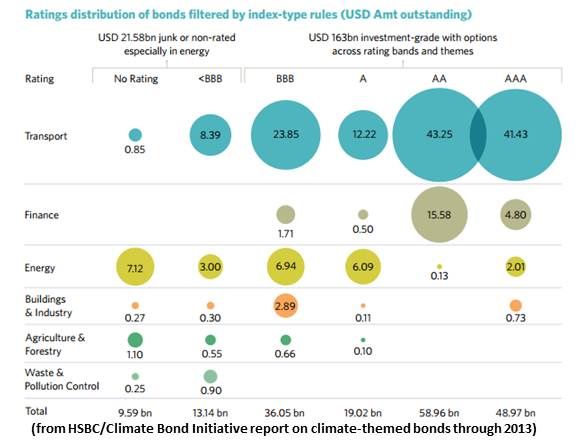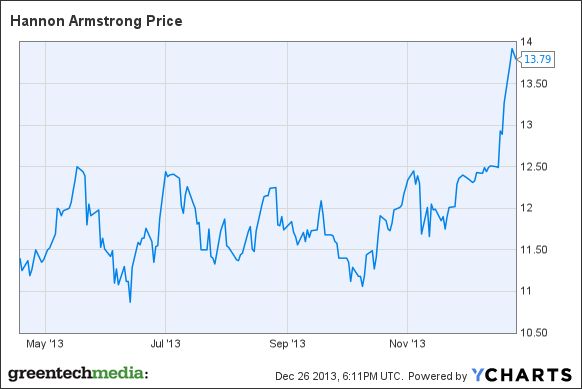Infrastructure investor Hannon Armstrong took a big step toward a new clean energy investor pool with the launch of its $100 million green bond offering.
“This is the securitization of assets that were on our balance sheet,” said Jeffrey Eckel, Hannon Armstrong Sustainable Infrastructure (NYSE:HASI) CEO and President. The bonds will mature in December 2019 and are backed by 100 individual wind, solar, and energy efficiency infrastructure installations at twenty properties valued at approximately $110 million.
“The coupon on the transaction is a very competitive 2.79 percent,” Eckel added.
The report Bonds and Climate Change: The State of the Market in 2013 from HSBC and The Climate Bond Initiative states, “Almost 30 percent of bonds [have] yields of less than 1 percent, and 40 percent [are] in the 1 percent to 3 percent yield bracket.” Only about $35 billion of the $346 billion in climate-themed bonds “have yields of 3 percent or higher.”
In April, Hannon Armstrong launched the first U.S. real estate investment trust (REIT) for renewables and energy efficiency infrastructure. Its underwriters are Bank of America Merrill Lynch, UBS, and Wells Fargo.
Hannon Armstrong’s bonds have no neutral agency credit rating. “We’ve done about $3 billion in asset-backed securitizations since 2000, none of which have an external rating,” Eckel said. “We describe the bonds as investment-grade, which is the minimum threshold.”

As a private placement, there is no disclosure of the bonds’ investors or component assets.
“The bonds are backed by contracted cash flows generated by wind, solar, and energy efficiency assets, and investors can see the underlying investment-grade credit quality of the obligor, the quality of the equipment, the strength of the contracts, and the sound project structures,” Eckel said.
“But the thing investors should look at is the greenhouse-gas rating of this bond,” he added. The bonds promise 61,036 metric tons, or 0.61 metric tons per $1,000 of bond value, of greenhouse gas mitigation. Many green bond offerings “are ill-defined in terms of GHG reductions,” Eckel said. “People should be able to know how green a 'green bond' is.”
The new HASI Series 2013-1 Sustainable Yield Bond offering is the second phase of HA’s move toward a target of “$2 of debt for every dollar of equity,” according to Eckel.
But this step is “to term out some of our interest rate exposure,” Eckel explained. The REIT is “a short-term interest rate, one month LIBOR facility. By taking some assets in our floating rate facility and extending it out to a six-year tenor, we’ve taken six years of interest rate fluctuations off the table.”
The HA REIT got an “outperform” rating from Baird Equity Research analysts Ben Kallo and Tyler Frank. They also added, “We believe a secondary offering will likely expand investor base and improve liquidity.”
Industrial and financial partners in the Global 1000 like Johnson Controls, Schneider Electric, Honeywell, Siemens, Exelon, Chevron, and Ameresco, the analysts said, will “play an ongoing and key role in driving HASI’s pipeline.” And, Baird noted, HA will likely capture a part of the federal government’s just-targeted $2 billion in energy efficiency upgrades.
The analysts concerns included:
- Risks related to cost reduction guarantees made by the REIT’s ESCOs
- A natural gas price drop that makes renewables and efficiency upgrades less competitive
- Concentration risk
- An interest rate drop that undercuts the REIT or bond return
- A disruption to underlying generation projects
The next phase in HA’s plans would be to “issue publicly rated and traded debt and facilitate additional investment opportunities [in] supporting sustainable infrastructure," Eckel said.
The REIT and bonds are part of the new generation of greentech vehicles for public investors that also include new tax equity opportunities, securitization, master limited partnerships (MLPs), and the Greenbacker Renewable Energy Company, a yield co from the financial startup Greenbacker Group. These emerging opportunities are aimed at the much bigger pool of capital in the hands of smaller investors.
The first green bond was issued in 2008 by the World Bank, and the market is growing rapidly. Some $10 billion was raised in green bonds in 2013, according to Reuters. It was “a fraction of the multi-trillion-dollar global bond market” but included the launch of important corporate green bonds.
Air Liquide, a French gas company, offered the first corporate green bond in October 2012. In November 2013, EDF’s "record-breaking 1.4 billion euro ($1.9 billion) deal was broadly similar to its non-green bonds,” Reuters reported, and Swedish property group Vasakronan added another.
"It clearly shows that the market has got to its critical mass,” Olga Dyakova, European Bank for Reconstruction and Development senior fund manager, told Reuters.
“Hannon Armstrong’s management sees climate change as a defining issue of our generation, and we think we have solutions,” Eckel said. “The bond is another way to attract capital to sustainability investment.”




